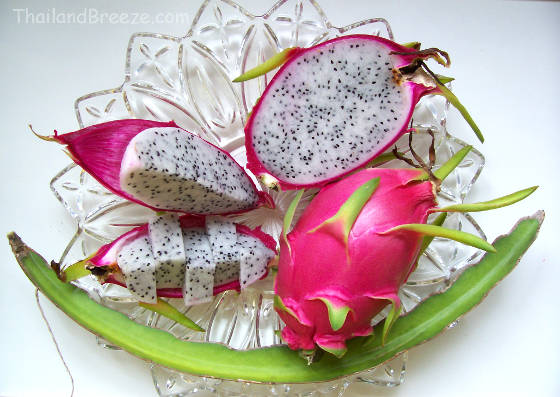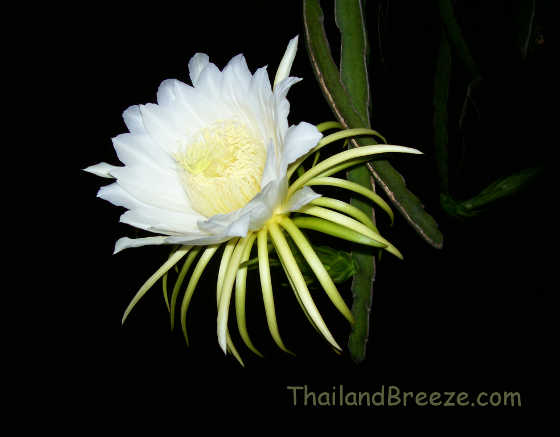Dragon Fruit



Have you ever thought that a skinny cactus could yield such a unique-looking fruit, that is edible? In this post, I'll introduce you to dragon fruit.
Dragon fruit is also known as pitaya or pitahaya. It grows on dragon fruit cactus that is native to Central and South America.
Dragon fruits are oval, reddish-pink fruits. The leather-like skin is partially covered with green scales, and the pulp has small black seeds all over, that look like kiwi seeds.
The most common breed cultivated in Thailand has white meat. The other kind, has dark red flesh and somewhat more flavor.
Dragon fruit has a mild taste, yet it's refreshing, especially when refrigerated. It is low in cholesterol and sugar, but high in antioxidants and vitamin C.

Cut white dragon fruit goes well in fruit salad, while the dark red variety is popular in fruit shakes because it makes the drinks really colorful.
An easy way to eat dragon fruit is to cut it in half and scoop the meat out. Otherwise, cut the fruit lengthwise. The skin peels off easily.
Dragon Fruit Flowers

Dragon fruit flowers are really beautiful. In full bloom, they can be the size of a large open hand. The fragrant white flowers start to bloom in the evening and open up fully late at night. Then, they wilt in a matter of hours.
How To Select Dragon Fruits
The fruit that is picked at the peak of ripeness is particularly tasty. It has thin shiny skin that is bright reddish pink. Look for these qualities when you buy dragon fruits.
If the skin is thick and more green than red, it normally means the fruit was picked too early.
When the skin looks really dry and the scales around the fruit have turned brown, it's a sign that it is overripe or has been on the shelf for too long.
Fresh dragon fruits can be stored in a dry plastic bag in the fridge, for up to 2 weeks.
In Thailand, the dragon fruit season is from May to October.
Have you ever thought that a skinny cactus could yield such a unique-looking fruit, that is edible? In this post, I'll introduce you to dragon fruit.
Dragon fruit is also known as pitaya or pitahaya. It grows on dragon fruit cactus that is native to Central and South America.
Dragon fruits are oval, reddish-pink fruits. The leather-like skin is partially covered with green scales, and the pulp has small black seeds all over, that look like kiwi seeds.
The most common breed cultivated in Thailand has white meat. The other kind, has dark red flesh and somewhat more flavor.
Dragon fruit has a mild taste, yet it's refreshing, especially when refrigerated. It is low in cholesterol and sugar, but high in antioxidants and vitamin C.
Dragon fruit is also known as pitaya or pitahaya. It grows on dragon fruit cactus that is native to Central and South America.
Dragon fruits are oval, reddish-pink fruits. The leather-like skin is partially covered with green scales, and the pulp has small black seeds all over, that look like kiwi seeds.
The most common breed cultivated in Thailand has white meat. The other kind, has dark red flesh and somewhat more flavor.
Dragon fruit has a mild taste, yet it's refreshing, especially when refrigerated. It is low in cholesterol and sugar, but high in antioxidants and vitamin C.
 |
Cut white dragon fruit goes well in fruit salad, while the dark red variety is popular in fruit shakes because it makes the drinks really colorful.
An easy way to eat dragon fruit is to cut it in half and scoop the meat out. Otherwise, cut the fruit lengthwise. The skin peels off easily.
An easy way to eat dragon fruit is to cut it in half and scoop the meat out. Otherwise, cut the fruit lengthwise. The skin peels off easily.
Dragon Fruit Flowers
 |
Dragon fruit flowers are really beautiful. In full bloom, they can be the size of a large open hand. The fragrant white flowers start to bloom in the evening and open up fully late at night. Then, they wilt in a matter of hours.
How To Select Dragon Fruits
The fruit that is picked at the peak of ripeness is particularly tasty. It has thin shiny skin that is bright reddish pink. Look for these qualities when you buy dragon fruits.
If the skin is thick and more green than red, it normally means the fruit was picked too early.
When the skin looks really dry and the scales around the fruit have turned brown, it's a sign that it is overripe or has been on the shelf for too long.
Fresh dragon fruits can be stored in a dry plastic bag in the fridge, for up to 2 weeks.
In Thailand, the dragon fruit season is from May to October.
If the skin is thick and more green than red, it normally means the fruit was picked too early.
When the skin looks really dry and the scales around the fruit have turned brown, it's a sign that it is overripe or has been on the shelf for too long.
Fresh dragon fruits can be stored in a dry plastic bag in the fridge, for up to 2 weeks.
In Thailand, the dragon fruit season is from May to October.
